Muir and I attended a 2 day workshop in Argyll organised by Argyll Fisheries Trust, funded by Ibis and delivered (in part) by the Wild Trout Trust to examine the benefits and see the improvements of introducing (or leaving) Large Woody Debris (LWD) in rivers.
This excellent event was a demonstration of techniques to introduce LWD into burns and rivers where fish habitat has been reduced in quality and quantity by man. We have plenty of burns and areas of rivers that have been altered, modified or degraded for one reason or another so these techniques have long been of interest to the Trust and we currently seek funding for a large project that we hope to deliver on the Water of Assel in the Stinchar valley. We intend to use some of the techniques that we saw demonstrated during the workshop to restore natural processes and to reduce erosion. Similarly, we hope to deliver improvements on the Culroy on the Doon using a range of ‘green’ engineering techniques.
It is important to stress that introducing LWD requires SEPA approval and depending on what and how much work is planned, a registration or CAR licence may be required. It is essential that there are clear aims in place and an understanding of the processes that occur and why; before anyone steps into a river with a chainsaw and starts felling trees. We will be very happy to look at areas that clubs or owners would like to improve in advance of firm and possibly damaging plans being developed. A bit of advice can save lots of problems!
We visited the River Shira near the head of Loch Fyne to see problems and to discuss and then finally make some improvements. Understanding the problems is key to working out suitable solutions. The Shira is a predominanty a seatrout river although salmon do spawn in the upper reaches. It suffers from abstraction and controlled flows as a result of 3 hydro schemes in the catchment. Forestry also contributes to the problem of fine sediment. Sea trout numbers crashed in the 90’s largely due to the poor positioning of aquaculture cages near the mouth of the river. These have been relocated and stocks are improving. Another main problem is historic straightening that dates back to the 1800’s. The river is now constrained in a channel by revetments built with river boulders and lined by trees. Livestock grazing is evident which weakens the banks leading to accelerated erosion. The coarser substrates on the river bed are buried below tonnes of fine sediment and spawning opportunities are lacking. Consequently the river is overwide, shallow, uniform and featureless with the result that there are fewer juveniles than should be expected and this in turn leads to fewer returning adults.
Erosion has led to trees collapsing into the river and where these lodge, the habitat immediately improves. The tenant farmer’s concerns over flooding led them historically to remove all fallen timber so there was little opportunity for improvement. More recently, finances have been restrictive for such practices and trees have been left where they fell and have either lodged or washed out to sea. Where they remain, scour has occurred and increased depth, cleaned gravels and sediments, causing side and point bars to form through deposition, all of which breaks up the unnatural uniform flow and improves the habitat for all species. The purpose of the workshop was to demonstrate ways in which this natural restoration process could be assisted for the benefit of fish and farmer by using introduced LWD. The aim is to prevent erosion yet at the same time create improved fish cover and habitat leading to a win win situation for all involved.
Thanks to Argyll FT, IBIS and the Wild Trout Trust for their excellent workshop and hospitality and 10/10 for arranging good, midge free weather!!
The annotated photos below illustrate a sample of problems and simple improvements.
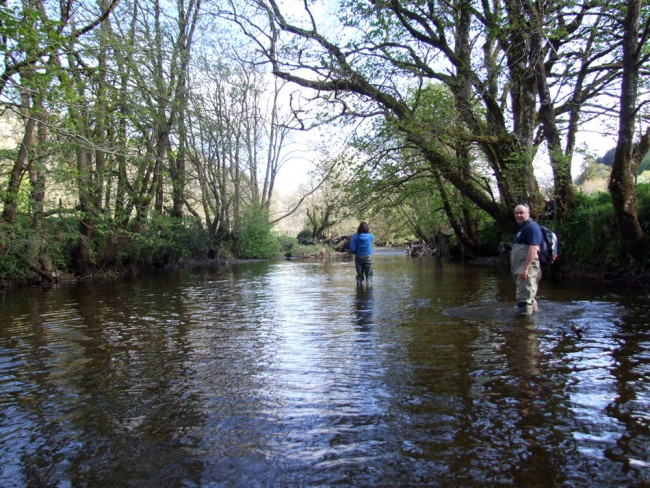
Over wide, shallow, straightened, bank revetments and featureless. This section of the Shira offered little suitable habitat for fish or invertebrates
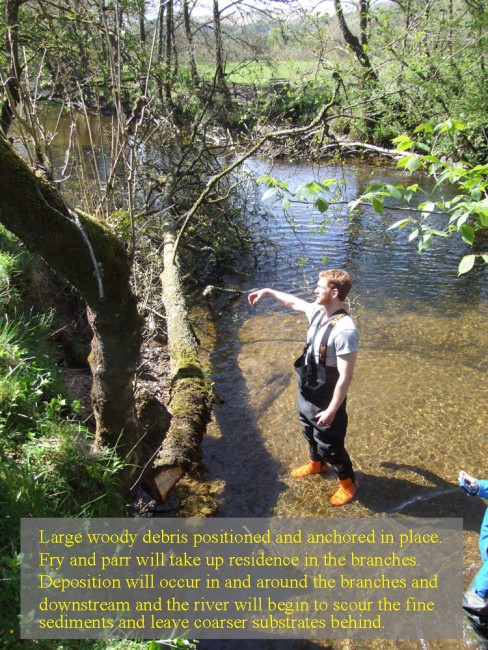
Newly felled LWD that is attached to the stump by wire rope. This will remain in place and restore natural processes vital to improve fish habitat
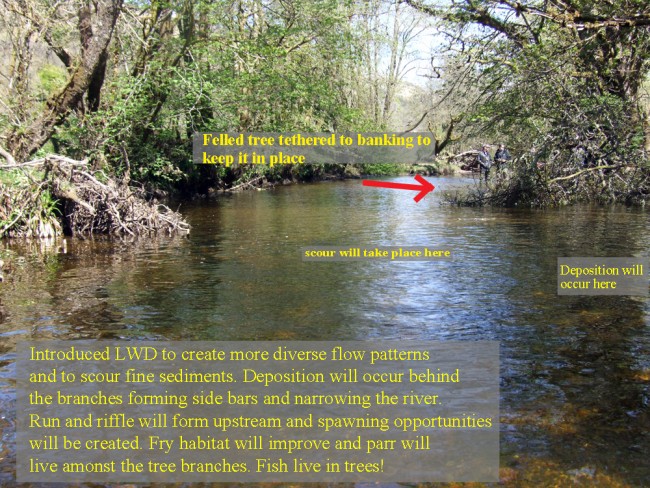
The same stretch following the addition of LWD. It will be interesting to see how quickly things improve
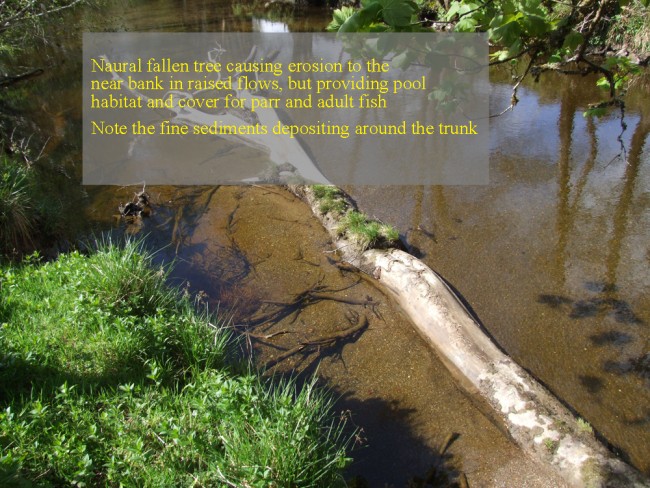
This tree arrived there naturally and has caused about 20m of deep pool habitat to form along the near bank but it is also causing erosion that the landowner may wish to avoid. It is important to monitor each situation carefully. Rivers naturally change course and although this doesn’t always suit landowners, it is a fact of life. The main issues affecting this river are due to man made alterations.
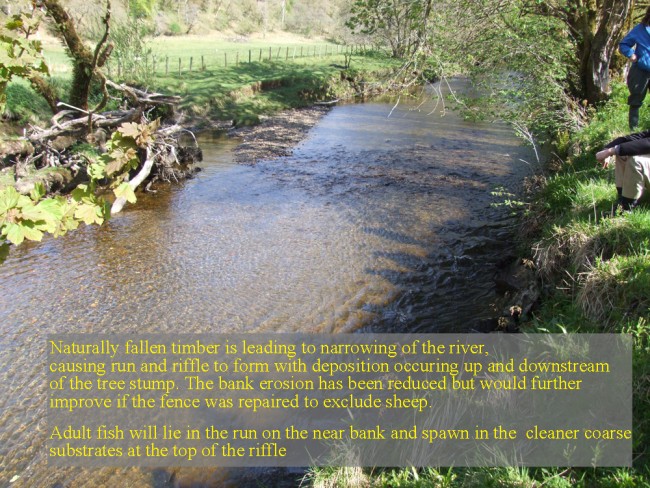



I know this is a silly and very basic question, but forgive a complete ignoramus please, what is the difference between a salmon river and a sea trout river; apart from the obvious one contains the former and not the latter and vice versa, what makes it so?
Well it’s not a silly question nor is it easy to answer as I don’t think there are any hard and fast rules that can be applied. Of course salmon and sea trout often both spawn in the same burn but usually in different areas. The key factor has to be the habitat. The Shira that was mentioned in my report is best known as a sea trout river but that doesn’t mean salmon don’t spawn there. Alan Kettle White informed me that the salmon tend to spawn further upstream in the steeper gradient areas and that would indicate that the habitat is more suitable for them there. As you will have seen in the post, substrates in the lower river are dominated by fine sediment (not mud, but gravel) and this isn’t ideal for either trout or salmon but especially salmon as they like coarser substrates in which to lay their eggs. Cobbles were buried by the finer substrates lower down the Shira and perhaps through time as the river manages to restore itself (with the help of additional woody debris to speed up the process) salmon may start spawning further downstream (salmon prefer and are able to move larger substrates during spawning than trout. It got to be a habitat issue I’m sure but it’s not always easy to identify what makes a river favoured by trout or salmon. I am keen to see how the Craufurdland and Fenwick Waters develop once stocking ceases (only on the Fenwick). We know salmon are making it up to spawn and have done for a year or two and numbers will quickly improve, but sea trout also head upstream. Will either river develop particularly as a sea trout burn whilst the other improves for salmon? Time will tell and until we start to gather the evidence, then I’ll not say any more but I have an inkling how these waters will fare.
Thanks for this – a really interesting post and comments.